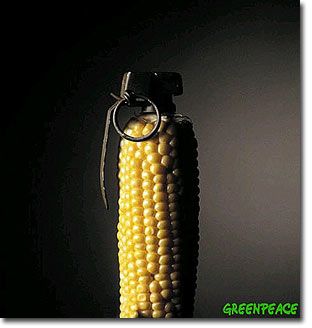
Publisher:
Bonnie King
CONTACT:
Newsroom@Salem-news.com
Advertising:
Adsales@Salem-news.com

~Truth~
~Justice~
~Peace~
TJP
Mar-10-2011 00:31

 TweetFollow @OregonNews
TweetFollow @OregonNews
The Two Faces of Genetic Engineering
JD Adams Salem-News.comGenetic engineering differs from the ancient technique of artificial selection in that the manipulation of genetic material occurs in a manner that is totally unnatural.
 From the article: The new weapons of genetic engineering - grain.org |
(SALEM, Ore.) - On one side, the bio-engineering industry promises a utopian world of bountiful food, where sickness and human imperfections are a thing of the past. On the other side is mounting evidence of biological monstrosities that threaten to turn the Earth into a scene from the horror movie "The Island of Dr. Moreau."
The modern era of genetic engineering began with the discovery of the double-helix structure of DNA by James Watson and Francis Crick in 1953. In 1962 Watson, Crick, and Maurice Wilkins were awarded the Nobel Prize for Physiology or Medicine for their contributions to the understanding of nucleic acids and genetics. They were supported toward this end by unpublished DNA X-ray diffraction data collected by colleague Rosalind Franklin, leading to a controversy over whether her name should have appeared along with Watson and Crick on the original paper detailing the molecular structure of DNA. James Watson went on to write the 'The Double Helix' in 1968, and in 1990 was appointed the Head of the Human Genome Project at the National Institute of Health. The future controversial nature of genetic engineering was presaged by Watson's departure from the Genome Project because he objected to attempted patents on human gene sequences.
Genetic engineering differs from the ancient technique of artificial selection in that the manipulation of genetic material occurs in a manner that is totally unnatural. It may involve borrowed heritable genetic material external to the organism, or the targeting of specific genes for elimination. Cloning and stem cell research are related technologies that may encompass genetic engineering, and the latest discipline is synthetic biology that seeks to introduce uniquely man-made materials into a genetic framework.

The applications of genetic engineering (GE) are so diverse as to be mind-boggling. The manipulation of bacteria and yeast genes have yielded industrial applications including the production of various drugs, vaccines, antibodies, insulin, hormones, supplements, and fuels. Animal models of human diseases, usually using mice, are made through GE. Research is progressing with genetically modified pigs that will grow human organs for transplant, and one day beef may be produced without cattle. GE promises to replace defective human genes with improved copies, one of the pillars of the Trans-humanist movement. GE can assist in cleaning up oil spills, and will be used to dispose of toxic waste, and detecting other environmental hazards. A genetically engineered virus has also been used to create an eco-friendly lithium-ion battery, and GE has been used to produce photographic images, Bio-Art, glowing fish, and blue roses. While stem cell research and many applications of GE appear benevolent and useful, the rapid pace of development coupled with the lure of untold profit have interfered with proper attention to the attendant hazards of tampering with nature.
In what is perhaps a chilling preview of our bio-engineered future, Gulf Coast residents are complaining of mysterious rashes and other ailments that are collectively referred to as the the Gulf Blue Plague: http://www.huffingtonpost.com/riki-ott/bio-remediation-or-bio-ha_b_720461.html
The issues with genetically modified organisms that are being avoided by the major media are that not only are these microbes spreading beyond their points of application, but they are capable of cross-breeding, creating a genetic witch's brew. It is a biological catastrophe in the making, with implications that stagger the imagination: http://worldvisionportal.org/wordpress/index.php/2011/02/gulf-synthetic-genes-crossing-species-barriers/

The first genetically modified food appeared in 1994. It is the agricultural applications of GE that have generated the most concerns and controversy. The first wave of crops to be genetically engineered were made to be resistant to insect pests, fungal infestations, viruses, and herbicides, with the intent of improving yield management and reducing the use of fertilizers and pesticides. The next generation of GE focused on improving the nutritional value of crops, or tolerance to cold, drought, and salt. Advancing technology eventually yielded pharmaceutical crops that expressed substances with medical applications. Certain farm animals have also been modified to secrete higher levels of growth hormone for increased size, or to give milk that contains valuable drugs or proteins.
Genetically modified food has raised concerns about potential toxicity and allergic reactions, especially since the nutrient profile of a particular food may be altered in unexpected ways. Within the U.S. the public perception is generally that GE foods are safe, but in Japan and Europe the technology remains controversial. The concept of "substantial equivalence" has been instituted to allay the fears of consumers about the safety of GE foods: "Substantial equivalence embodies the concept that if a new food or food component is found to be substantially equivalent to an existing food or food component, it can be treated in the same manner with respect to safety (i.e., the food or food component can be concluded to be as safe as the conventional food or food component)" (Joint FAO/WHO Biotechnology and Food Safety Report, 1996, p. 4).

Consumer rights groups such as the Organic Consumers Association are pressing for more in-depth investigations into the long-term health and environmental risks of genetically modified foods. A 2009 review in Nutrition Reviews found that although most studies concluded that GM foods do not differ in nutrition or cause any detectable toxic effects in animals, some studies did report adverse changes at a cellular level caused by some GM foods, concluding that "More scientific effort and investigation is needed to ensure that consumption of GM foods is not likely to provoke any form of health problem". The assessment of GE foods by the scientific community has been mixed, and the basis for substantial equivalence is problematic, being that the comparison to unmodified foods is uncertain because our normal diets have never been formally proven to be safe.
The issue of conflict of interest has also been raised because substantial equivalence testing by bio-tech industries had approved GE foods such as Roundup ready soy that proved to have a substantially different nutrient profile compared to unmodified soy. Most disturbing is the fact that independent analysis of GE foods is stifled by restrictive end-user agreements, effectively forbidding researchers from publishing their findings without approval from agritech companies.
In a statement to the EPA, Elson Shields of Cornell University noted that "As a result of restrictive access, no truly independent research can be legally conducted on many critical questions regarding the technology", and the Scientific American noted that several studies that were initially approved by seed companies were later blocked from publication when they returned "unflattering" results. Professor Bela Darvas of Debrecen University found that Monsanto engineered corn was lethal to two protected Hungarian insect species, and another rare species of insect.
A 2010 study in North Dakota found engineered genes in 80% of wild plants, with the highest densities occurring near farm fields and and major highways. The implication in the immediate future is that many common weeds would possess immunity from herbicides and insects, but in the long-term the scenario could encompass bizarre interactions between pharmaceutical crops that can scarcely be imagined.
Lingering hazards exist today from the bio-engineering programs of the Cold War period. Soviet defector Ken Alibek confirmed in 1992 that the Soviets had stockpiled as much as twenty tons of the deadly smallpox virus which had possibly been genetically engineered to be vaccine resistant, along with refrigerated warheads. In 1997 the smallpox weaponry was moved to the Vector Institute, although the ramifications of this are unclear. With the fragmentation of the Soviet Union there is concern that the technology to weaponize smallpox may migrate to terrorist groups.
Sources:
http://en.wikipedia.org/wiki/
http://en.wikipedia.org/wiki/
http://en.wikipedia.org/wiki/
http://en.wikipedia.org/wiki/
http://en.wikipedia.org/wiki/
http://en.wikipedia.org/wiki/
 J. D. Adams was born in Salem, Oregon, a descendant of Oregon Trail pioneer William Lysander Adams. As a wilderness explorer, photographer, and writer, he sustains a kinship with the spirit of the Oregon country. JD inhabits Oregon's Silicon Forest as an electronics professional with degrees in Electronics Engineering Technology and Microelectronics.
J. D. Adams was born in Salem, Oregon, a descendant of Oregon Trail pioneer William Lysander Adams. As a wilderness explorer, photographer, and writer, he sustains a kinship with the spirit of the Oregon country. JD inhabits Oregon's Silicon Forest as an electronics professional with degrees in Electronics Engineering Technology and Microelectronics.
He maintains a Web presence with a signature presentation in genres including travel, history, and technology.
You can write to Jim Adams at this email address: j1mcm0s@earthlink.net
Also, visit Jim's Website: home.earthlink.net/~j1mcm0s/
Articles for March 9, 2011 | Articles for March 10, 2011 | Articles for March 11, 2011

googlec507860f6901db00.html
Salem-News.com:



Terms of Service | Privacy Policy
All comments and messages are approved by people and self promotional links or unacceptable comments are denied.
a Canadian March 11, 2011 12:00 pm (Pacific time)
We are fighting the introduction of GE Alfalfa here. Both our governments each gave Monsanto $600 Million for research. As always, we get to finance our own destruction.
JDA March 11, 2011 1:15 pm (Pacific time)
The FDA does not require mandatory labeling of genetically engineered foods as such, but does require labeling if the nutrient profile is significantly different from unmodified food, if the food contains an unexpected allergen, or it contains a toxic substance beyond an acceptable limit.
france g March 10, 2011 6:11 pm (Pacific time)
Thank you for this article. I hope the state of Oregon with its big agra-industry will ban all GMO's. We can't trust the FDA,EPA or the USDA with our food supply. Everybody please read all food labels and reject Genetically Modified food and the feeding of such to our meat supply.
Toni Reita ND March 10, 2011 12:07 pm (Pacific time)
Europeans must easily question our sanity. Thirty countries, including Australia, Japan and all European countries have banned or have significant restrictions on GMO's. The USDA, FDA continue to protect corporations rather than humans, based on studies created by the very same companies who profit from the sale of GMO's. We live in a twisted, corrupt world. It's simple, real people need real food. http://www.natural-health-home-remedies.com/gmo.html
[Return to Top]©2025 Salem-News.com. All opinions expressed in this article are those of the author and do not necessarily reflect those of Salem-News.com.